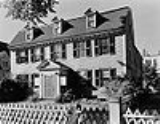
William Brattle House
Encyclopedia
The William Brattle House is an historic house at 42 Brattle Street
in Cambridge, Massachusetts
. It is one of the seven Colonial mansions described by historian Samuel Atkins Eliot
as making up Tory Row
.
. After the 1774 incident known as the Powder Alarm
, an angry mob surrounded the Brattle mansion and forced the family to flee to Boston.
According to Edward Abbott, writing in 1859,
For a time, the William Brattle House was home to American journalist Margaret Fuller
. Fuller's uncle Abraham owned the home at the time, and the Fuller family moved in shortly after Timothy Fuller
's unsuccessful campaign for lieutenant governor of Massachusetts as an Anti-Mason
. They arrived in September 1831 and left by April 1833.
It was added to the National Register of Historic Places
in 1973. It is currently owned and maintained by the Cambridge Center for Adult Education
, a non-profit organization that was incorporated in 1938. CCAE also owns the historic Dexter Pratt House
.
Brattle Street (Cambridge, Massachusetts)
Brattle Street in Cambridge, Massachusetts, called the "King's Highway" or "Tory Row" before the American Revolutionary War, is the site of many buildings of historic interest, including the modernist glass-and-concrete building that housed the Design Research store,and a Georgian mansion where...
in Cambridge, Massachusetts
Cambridge, Massachusetts
Cambridge is a city in Middlesex County, Massachusetts, United States, in the Greater Boston area. It was named in honor of the University of Cambridge in England, an important center of the Puritan theology embraced by the town's founders. Cambridge is home to two of the world's most prominent...
. It is one of the seven Colonial mansions described by historian Samuel Atkins Eliot
Samuel Atkins Eliot
Samuel Atkins Eliot, A.M., D.D. was an American Unitarian clergyman, son of Charles W. Eliot and grandson of Samuel Atkins Eliot, the politician. For more on his lineage see the Eliot family....
as making up Tory Row
Tory Row
Tory Row is the nickname historically given by some to the part of Brattle Street in Cambridge, Massachusetts where many Loyalists had mansions at the time of the American Revolutionary War, and given by others to seven Colonial mansions along Brattle Street...
.
History
The house was built in 1727 for General-Major William Brattle, at that time the wealthiest man in the Massachusetts Bay ColonyMassachusetts Bay Colony
The Massachusetts Bay Colony was an English settlement on the east coast of North America in the 17th century, in New England, situated around the present-day cities of Salem and Boston. The territory administered by the colony included much of present-day central New England, including portions...
. After the 1774 incident known as the Powder Alarm
Powder Alarm
The Powder Alarm was a massive popular reaction to the removal of gunpowder from a magazine by British soldiers under orders from General Thomas Gage, royal governor of the Province of Massachusetts Bay, on September 1, 1774...
, an angry mob surrounded the Brattle mansion and forced the family to flee to Boston.
According to Edward Abbott, writing in 1859,
General Brattle conveyed all his real estate in Cambridge, December 13, 1774, to his only surviving son, Major Thomas Brattle...By the persevering efforts of Mrs. Katherine Wendell, the only surviving daughter of General Brattle, the estate was preserved from confiscation, and was recovered by Major Brattle after his return from Europe,—having been proscribed in 1778, and having subsequently exhibited satisfactory evidence of his friendship to his country and its political independence.
For a time, the William Brattle House was home to American journalist Margaret Fuller
Margaret Fuller
Sarah Margaret Fuller Ossoli, commonly known as Margaret Fuller, was an American journalist, critic, and women's rights advocate associated with the American transcendentalism movement. She was the first full-time American female book reviewer in journalism...
. Fuller's uncle Abraham owned the home at the time, and the Fuller family moved in shortly after Timothy Fuller
Timothy Fuller
Timothy Fuller was a U.S. Representative from Massachusetts.-Life and work:Fuller was born in Chilmark, Massachusetts. His father, Timothy, the first settled minister of Princeton, Mass., was third in descent, from Thomas, who emigrated from England in 1638...
's unsuccessful campaign for lieutenant governor of Massachusetts as an Anti-Mason
Anti-Masonic Party
The Anti-Masonic Party was the first "third party" in the United States. It strongly opposed Freemasonry and was founded as a single-issue party aspiring to become a major party....
. They arrived in September 1831 and left by April 1833.
It was added to the National Register of Historic Places
National Register of Historic Places
The National Register of Historic Places is the United States government's official list of districts, sites, buildings, structures, and objects deemed worthy of preservation...
in 1973. It is currently owned and maintained by the Cambridge Center for Adult Education
Cambridge Center for Adult Education
The Cambridge Center for Adult Education , a non-profit corporation in Cambridge, Massachusetts, has been teaching adult education courses at 42 Brattle Street since taking over the building from the Cambridge Social Union in 1938...
, a non-profit organization that was incorporated in 1938. CCAE also owns the historic Dexter Pratt House
Dexter Pratt House
Dexter Pratt House is an historic house at 54 Brattle Street in Cambridge, Massachusetts.The house was built in 1808 and added to the National Register of Historic Places in 1973. Dexter Pratt was the village blacksmith that inspired Henry Wadsworth Longfellow's poem "The Village Blacksmith"...
.

